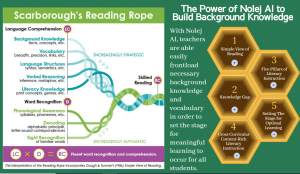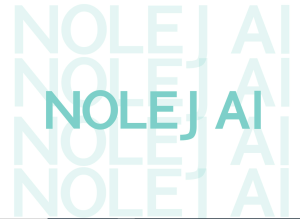16 Enhancing Comprehension by Building Essential Background Knowledge using Nolej AI
Stacey Moser
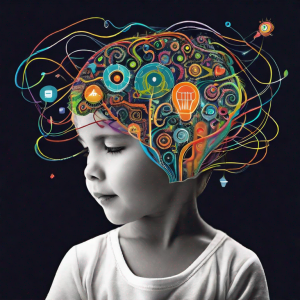
Image created with Morpheus image generator.
Prompt: a child with connecting concepts growing out of her head.
Introduction
Building background knowledge is the foundation that strong comprehension is built upon. This background knowledge, often referred to as prior knowledge or schema, is the web of information and experiences we accumulate throughout our lives. It is this bank of background knowledge that provides the foundation upon which new information is processed, understood and integrated. Understanding the crucial role background knowledge plays in comprehension makes Nolej AI a powerful tool in a teacher’s toolbox. Nolej AI has the ability to take teachers’ curated videos, slideshows, documents or audio to create robust, bite-sized, gamified learning experiences to activate and build students’ background knowledge creating an optimal learning environment.
While some children enter school lucky in literacy experiences with robust background knowledge and vocabulary, many of our students do not share that same experience. This limited background knowledge and vocabulary puts a student at a disadvantage. We begin to see evidence of the Matthew Effect wherein the rich get richer and the poor get poorer (“Article-A-Day,” n.d.). Our classrooms are also growing daily with little ones who are new to Canada. They may have strong decoding skills but their comprehension may be weak because they lack language comprehension skills such as background knowledge, vocabulary and syntax. Designing instruction to support these readers is imperative but instruction that enhances language comprehension really is just best practice for all. How do we design our instruction so that all learners have access to building robust schema and vocabulary without overextending our teachers? Enter AI…more specifically Nolej AI.
Explore NoleJ AI to Build Background Knowledge
Critical Media Literacy (connection to Curriculum)
Background knowledge is considered a foundational element in our Saskatchewan English Language Arts (ELA) curriculum. It supports reading comprehension, critical thinking, effective communication, literacy understanding, media literacy, vocabulary enrichment and cross-curricular connections. It is essential for students to be able to engage meaningfully with texts, analyze information critically and communicate ideas effectively.
Our Comprehend and Respond ELA Outcomes ask students to read for various purposes and demonstrate comprehension of many types of text. These outcomes revolve around our students’ abilities to activate and apply their background knowledge to make connections, predictions and inferences while reading.
The curriculum also encourages critical thinking skills such as analyzing, evaluating and synthesizing information from texts. To do this, students must use their background knowledge to accept or reject information that aligns with their existing schema.
In terms of Media Literacy, students are expected to critically assess various forms of media. Background knowledge allows them to identify bias or propaganda and helps them to make informed decisions about the validity of the information they encounter in their world.
A strong vocabulary is also very important in becoming an effective communicator. Students use their background knowledge to infer meanings of unfamiliar words and expand their vocabularies.
Our ELA curriculum outcomes also encourage the integration of reading and writing across subject areas. Background knowledge acquired in Science, Social Studies, Math and other subjects strengthen the students’ ability to comprehend and respond in ELA.
Affordances and Constraints
| Affordances | Constraints |
| With Nolej AI, teachers are able to frontload necessary background and vocabulary in order to set the stage for meaningful learning to occur. Nolej AI provides an opportunity for the teacher to share a quick video, audio file, document or slideshow followed by gamified practice so that all students are able to enter a topic on a leveled playing field. | Although Nolej AI does have a free trial membership, this serves only to get you hooked on the product. The monthly membership is a little pricey for most teachers at $19.99USD/month. The yearly membership brings the price down to $16.67USD/month. |
| Nolej AI has the power to upload any curated resources a teacher may have such as YouTube videos, webpages, audio files, documents, webinars. Nolej AI then analyzes the meaning of what’s being discussed in those artifacts and autogenerates interactive learning content such as interactive videos, vocabulary cue cards, summaries, fill in the blank, multiple choice, matching and/or True/False questions within minutes and with minimal effort! | Even with this yearly membership, educators can only create 10 learning packages/month. |
| These interactive learning packages can be created in a number of different languages such as French, Italian, German, Portuguese, Spanish and Dutch. They can also be easily uploaded to LMS platforms like Google Classroom, Blackboard, Canvas, Schoolology and Moodle. | Nolej AI gives access to many different language users, but many languages represented in our ever-growing province are missing. Perhaps they will be able to add more languages as this app moves from its infancy into mainstream use. |
| Providing background knowledge and vocabulary building opportunities are essential for enhancing comprehension for all learners. This tool would be especially helpful for teachers of English as an Additional Language (EAL) Learners, high school students to build out Tier II or Tier III academic vocabulary and adult learners. Some of the most common recommendations on a newcomer’s Common Framework of Reference (CFR) language assessment report is to frontload academic language and provide background knowledge support. This is best practice for all students but often difficult for a teacher to do. Nolej AI could support the teacher to provide these powerful learning opportunities without additional stress. |
THE PROCESS
Using Nolej AI in 10 Easy Steps:
Step 1 – Sign into Nolej AI and create an account granting you a free 6 day trial.
Step 2 – Click on +Create

Step 3 – Select a language(English, French, Italian, German, Portuguese, Spanish, Dutch)
Step 4 – Add microlearning title

Step 5 – Choose the type of resource used to create learning content. I’ve chosen a YouTube video for this example. Then click Create Microlearning.
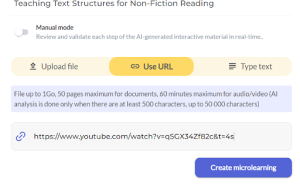
Step 6 – The resource will then be uploaded to AI to be transcribed and analyzed for its semantic meaning. Then Nolej AI will autogenerate interactive learning content.

Step 7 – Now it’s time to edit the gamified, interactive content that has been created for you.
![]()
Step 8- Review created Microlearning.
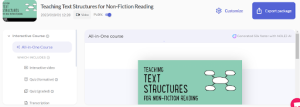
Step 9 – Customize it to meet the needs of your learners by clicking on Customize.
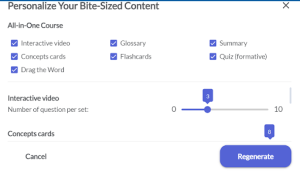
Step 10 – Assign it to learners through preferred platform by clicking on Export Package and let the learning begin!
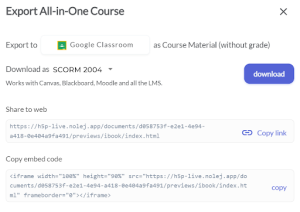
Try it out HERE ! – Teaching Text Structures For Non-Fiction Reading
Setting the stage to read the novel The One and Only Ivan using Nolej AI.
Prompt Engineering
Begin with the end in mind. What does the student need to know before entering into a new concept? What are the concepts we may assume the students know? What are the terms that need to be overtaught before additional learning can take place?
Upload curated slides, informative videos, webpages, podcasts, or any other video/audio files with the necessary content.
You have an opportunity to fix any errors in Nolej AI’s transcription and interpretation of meaning before it creates the micro-learnings. Careful attention needs to be done in that step to ensure that everything is accurate.
Recommendations
If you’d like to learn more about how Nolej AI can enhance comprehension by building background knowledge and vocabulary in your class, please check out:
Demo of Nolej AI in 2 minutes: https://www.youtube.com/watch?v=1hvtsMh8icE
Full Nolej AI demo: https://youtu.be/6bWidsVXX7I?
Nolej AI how to edit or review packages: https://youtu.be/rhpAynFaDb0?
Informative presentation
References
DeHart, J. (2023, September 28). AI-assisted writing: Concerns, benefits, and ethics. Voyager Sopris Learning. https://www.voyagersopris.com/blog/edview360/ai-assisted-writing-concerns-benefits-and-ethics
Horn, M., & Curtis, D. (2023, March 22). To teach better writing, don’t ban artificial intelligence. Instead, embrace it. Education Next. https://www.educationnext.org/teach-better-writing-dont-ban-artificial-intelligence-instead-embrace-it-inviting-chatgpt-into-classroom/
Saskatchewan Ministry of Education. (2018, November 22). English language arts 4 curriculum. https://curriculum.gov.sk.ca/CurriculumOutcomeContent?id=30&oc=64883
Educators using NOLEJ AI. (2023). YouTube. https://www.youtube.com/watch?v=bWEEhk6_WJs
Reece, T. (2023). Article-A-Day.: Building background knowledge and vocabulary. ReadWorks https://about.readworks.org/article-a-day-webinar.html
Acknowledgement of AI Use
ChatGPT aided me in writing a succinct explanation of how the brain uses background knowledge to support comprehension as well as explaining the important role of background knowledge in our provincial curriculum.

